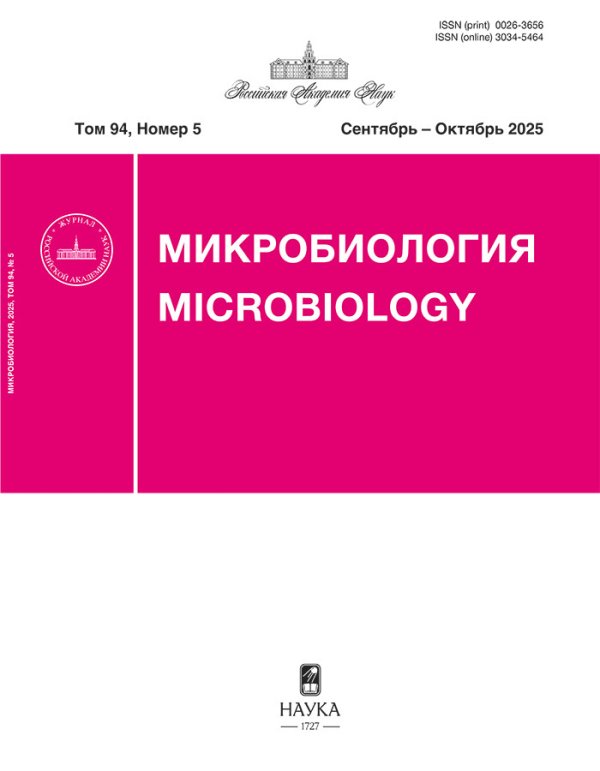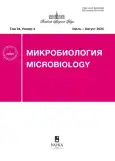Development of a protocol for transformation of Lacticaseibacillus paracasei RG
- Authors: Dudik P.S.1, Armyaninova D.K.1, Goncharenko A.V.1
-
Affiliations:
- FRC Biotechnology RAS
- Issue: Vol 94, No 4 (2025)
- Pages: 356-360
- Section: SHORT COMMUNICATIONS
- URL: https://rjsvd.com/0026-3656/article/view/686894
- DOI: https://doi.org/10.31857/S0026365625040054
- ID: 686894
Cite item
Abstract
Lactic acid bacteria, traditionally used in the food industry, are considered as a platform for the creation of recombinant strains for the expression and delivery of protectively significant antigens and other biologically active molecules to the gastrointestinal tract of farm animals and humans. One of the obstacles to obtaining recombinant strains of lactic acid bacteria is their low efficiency of plasmid DNA transformation. The probiotic strain Lacticaseibacillus paracasei RG, safe and able to overcome the acidic barrier of the stomach, was chosen as the object of research. The effect of growth conditions, preparation of competent cells and the electroporation mode on the efficiency of L. paracasei RG transformation with the pTRKH2 vector was studied, as a result of which a protocol for efficient transformation of L. paracasei RG with recombinant DNA was created.
Full Text
About the authors
P. S. Dudik
FRC Biotechnology RAS
Author for correspondence.
Email: polinadu05@gmail.com
Russian Federation, Moscow, 119071
D. K. Armyaninova
FRC Biotechnology RAS
Email: polinadu05@gmail.com
Russian Federation, Moscow, 119071
A. V. Goncharenko
FRC Biotechnology RAS
Email: polinadu05@gmail.com
Russian Federation, Moscow, 119071
References
- Государственная Фармакопея Российской Федерации. 13 изд. Т. 2. Капсулы ОФС. ОФС.1.7.2.0008.15. Россия: Москва, 2015.
- Börner R. A., Kandasamy V., Axelsen A. M., Nielsen A. T., Bosma E. F. Genome editing of lactic acid bacteria: opportunities for food, feed, pharma and biotech // FEMS Microbiol. Lett. 2019. V. 366. Art. fny291. P. 1–12. https://doi.org/10.1093/femsle/fny291
- LeCureux J.S., Dean G. A. Lactobacillus mucosal vaccine vectors: immune responses against bacterial and viral antigens // MSphere. 2018. V. 3. Art. e00061-18. https://doi.org/10.1128/msphere.00061-18
- Morovic W., Roper J., Smith A., Mukerji P., Stahl B., Caverly Rae J., Ouwehand A. C. Safety evaluation of HOWARU® Restore (Lactobacillus acidophilus NCFM, Lactobacillus paracasei Lpc-37, Bifidobacterium animalis subsp. lactis Bl-04 and B. lactis Bi-07) for antibiotic resistance, genomic risk factors, and acute toxicity // Food Chem. Toxicol. 2017. V. 110. P. 316‒324. https://doi.org/10.1016/j.fct.2017.10.037
- Nickoloff J. A. (ed.) Electroporation protocols for microorganisms. USA, New Jersey: Humana Press, 1995. 374 p.
- O’Sullivan D.J., Klaenhammer T. D. High- and low-copy-number Lactococcus shuttle cloning vectors with features for clone screening // Gene. 1993. V. 137. P. 227‒231. https://doi.org/10.1016/0378-1119(93)90011-Q
- Palomino M. M., Allievi C. M., Prado-Acosta M., Sanchez-Rivas C., Ruzal S. M. New method for electroporation of Lactobacillus species grown in high salt // J. Microbiol. Meth. 2010. V. 83. P. 164–167. https://doi.org/10.1016/j.mimet.2010.08.017
- Song X., Huang H., Xiong Z., Xia Y., Wang G., Yin B., Ai L. Characterization of a cryptic plasmid isolated from Lactobacillus casei CP002616 and construction of shuttle vectors based on its replicon // J. Dairy Sci. 2018. V. 101. P. 2875–2886. https://doi.org/10.3168/jds.2017-13771
- Welker D. L., Hughes J.E, Steele J. L., Broadbent J. R. High efficiency electrotransformation of Lactobacillus casei // FEMS Microbiol. Lett. 2015. V. 362. P. 1‒6. https://doi.org/10.1093/femsle/fnu033
- Welker D. L., Crowley B. L., Evans J. B., Welker M. H., Broadbent J. R., Roberts R. F., Mills D. A. Transformation of Lactiplantibacillus plantarum and Apilactobacillus kunkeei is influenced by recipient cell growth temperature, vector replicon, and DNA methylation // J. Microbiol. Meth. 2020. V. 175. Art. 105967. https://doi.org/10.1016/J.MIMET.2020.105967
- Wyszyńska A., Kobierecka P., Bardowski J., Jagusztyn-Krynicka E. K. Lactic acid bacteria – 20 years exploring their potential as live vectors for mucosal vaccination // Appl. Microbiol. Biotechnol. 2015. V. 99. P. 2967‒2977. https://doi.org/10.1007/S00253-015-6498-0
Supplementary files













